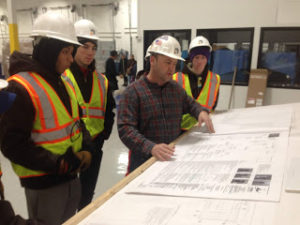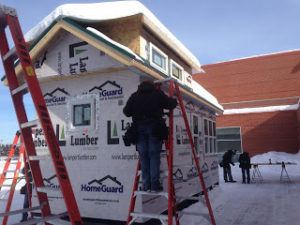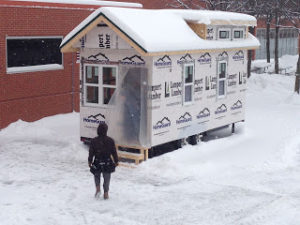New Construction Trades Program Creates Opportunity for Eagan High School Students to Build Skills and Learn about Careers In Construction
Eagan High School, located in the southeast suburbs of Minneapolis-St. Paul is among a growing number of high schools throughout Minnesota that are creating that are creating opportunities for students to learn practical construction skills that can be used for a lifetime, while learning about potential careers in construction.
Launched last year, the new, year-long, two-hour-per-day Construction Trades course introduces Eagan High School students to a third career option, a career as a professionally trained skilled construction professional, in addition to traditional paths such as attending a four-year college or entering military service. The program was launched with the assistance of a grant to ISD 196 of $31,368 from the Construction Careers Foundation.
“While many high schools focus mostly on college-bound students, at Eagan, we’re giving an equal level of attention to vocation-bound or non-college-bound students,” says Nick Johnson, who worked with Eagan High School instructors Ryan Hauenstein and Wayne Krantz to bring the new course to life.
According to Johnson, the construction courses build on other courses offered within the Industrial Arts program, which provide hands-on learning opportunities in the areas of woods and metals, graphic design, drafting, small engines and transportation, and home repair.

“We offer courses that provide our students a lifetime of skills that they can use both professionally, or recreationally,” says Johnson. “For example, with our courses, some students may envision themselves as a professional electrician or a cabinet maker. On the other hand, our courses can provide skills that allow a person to build things because they simply receive joy in making things or using their skills.”

For the new construction courses, Eagan high school students are building a “tiny” 8 foot x 20 foot home, which will be used as a cabin.
“The class provides students who like to put their knowledge and skills to task” says Hauenstein. “They get a chance to build a tiny house, from start to finish – from reading the plans and determining which materials they’ll need to actually framing the structure and finishing, including installing the plumbing and the electrical work.”
The class, which was launched in the first semester of the 2018-2019 school year, is geared towards juniors and seniors who have an interest in pursuing a career in construction. Don Mullin, executive secretary of the Saint Paul Building and Construction Trades Council, was a huge influence in helping Eagan launch its construction trades classes, according to Johnson.

“It’s a relatively new class, but already we’re off to a really good start,” Krantz says. “Last year, we had a dozen students enroll in the course. This year, we have eight students working on the tiny house, which is an ideal size given the small space we are building in.”

With a deadline of completing the tiny house by May 31st, the Construction Trades course offers students a completely different experience to that of a regular classroom. For students who often wonder how their studies will be applicable to their lives, this is the perfect class.
“As our students build the house, they quickly realize how critical the skills of technical reading, writing and communication are.
 There isn’t a day that passes without our kids actively putting to action math and science concepts,” Hauenstein says.
There isn’t a day that passes without our kids actively putting to action math and science concepts,” Hauenstein says.
In addition to building their construction skills, the Construction Trades course at Eagan also exposes students to unique job possibilities in construction for after they leave high school.
“As the year goes on, we talk about options after high school,” Krantz says. “We discuss apprenticeship programs and provide valuable resources to help students find a path that’s right for them. We like to expose them to as many options as possible.”
This is accomplished in a number of ways. Once a month, the students enrolled in the course will do a field trip to a construction site or to a union apprenticeship training center.
“We also like to bring in students who graduated from Eagan High School who have pursued a career in construction to come into our class and speak directly and frankly to our students,” Hauenstein says, “It’s important for our students to learn from former students, some of whom are not that much older themselves, about the steps they took to start a career in construction.”

Hauenstein and Krantz maintain a blog about these various experiences to help students who are curious about the Construction Trades course learn more about it.
Looking ahead, Johnson says that one of the primary goals of the new course is to increase the mix of students who enroll in the class.
“It’s important that all students, including female students, have the opportunity to explore careers in construction,” Johnson says. “It’s a great chance for them to apply intellectual skills in a hands-on way.”
It’s that commitment to introducing more students to the construction trades that led to a recent story about the Construction Trades course by WCCO-TV.
Eagan High School is one of a growing number of schools throughout Minnesota that offer classes to prepare students for apprenticeship programs in construction. These schools are known as Construction Apprenticeship Preparation (CAP) schools and they supported by Construction Career Pathways (CPP), a collaborative effort between Minnesota’s trade unions, construction companies, school districts, the State of Minnesota, and a number of nonprofits all dedicated to introducing careers in construction as a viable career option to Minnesota’s high school students.
Hauenstein and Krantz believe that the skills they teach in the Construction Trades class will not only help students in their careers but in their lives as well.
“What we’re really trying to do is help students decide whether or not a career in construction is for them.” Hauenstein says. “We want to get to the heart of the matter and ask them: ‘What is it that you really want to do?’ And then, whatever their goal is, we want to help them achieve it.”
To learn more about CAP schools, visit https://constructioncareers.org/cap-schools/
